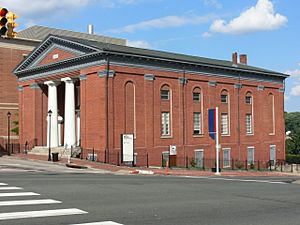First African Baptist Church (Richmond, Virginia) facts for kids
Quick facts for kids First African Baptist Church |
|
|---|---|

The old church building is now owned by the Medical College of Virginia.
|
|
| Location | Richmond, Virginia |
| Country | USA |
| Denomination | Baptist |
| Website | firstafricanbaptist.org |
| History | |
| Founded | 1841 |
The First African Baptist Church in Richmond, Virginia, is a historic Baptist church. It was started in 1841 by a group of both enslaved and free Black people. The church quickly became very important to the local Black community. For a time, it was one of the largest Protestant churches in the United States.
Contents
The Church's Story
The First African Baptist Church has a long and fascinating history. It began as part of another church and grew into a powerful center for the African American community in Richmond.
How the Church Began
Before 1841, many Black members worshiped at Richmond's First Baptist Church alongside white members. In fact, Black worshipers were the majority. This made some white members uncomfortable. Many Black members also wanted their own church because the building was often too crowded for everyone to get in.
In 1841, the white members decided to build a new church for themselves. They sold their old building, located at the corner of College Street and East Broad Street, to the Black members. This congregation became the First African Baptist Church. Its first members came from several Baptist churches in the city.
A Time of Amazing Growth
In 1866, a very talented preacher named James H. Holmes became the assistant pastor. Holmes had been born into slavery. A year later, in 1867, he became the main pastor. Under his leadership, the church grew incredibly fast. In 1871, he baptized 600 new members, and in 1878, he baptized 1,100 people!
By 1876, the congregation needed a new building. They tore down the old one and built a beautiful new church for $35,000. They also installed a large organ that cost $2,500. It was the biggest organ in any African American church at the time. The new building was designed by architect Thomas U. Walter in a grand style, similar to an ancient Greek temple.
A New Chapter
The congregation worshiped in their historic building on Broad Street for many years. In 1955, they moved to a new location. The old church building was sold to the Medical College of Virginia. Some people were sad about the sale. They felt it did not respect the church's important place in African-American history. Today, the building is used for offices and classrooms.
In February 2025, a plan was announced for the building's future. The plan proposed that Virginia Commonwealth University (VCU) would give the building to Virginia State University. It would then be leased to Virginia Union University to be used as a museum for its historical collection.
Church Life and Rules
Life at the First African Baptist Church was unique, especially in the years before the American Civil War.
Leadership and Learning
When the church first started, Virginia law made it illegal for Black people to be official preachers. Because of this, the first pastor, Robert Ryland, was a white man. He led the church from 1841 to 1865. However, the church was also guided by a board of thirty Black deacons.
Even though it was against the law to teach Black people to read, Pastor Ryland published a special book called a catechism. This book helped members learn to read while studying religious lessons. This was controversial, but Ryland argued that his lessons also taught respect for authority. The church also raised money to buy the freedom of some members who were gifted preachers.
After the Civil War, the church could finally have a Black senior pastor. In 1867, James H. Holmes, a former deacon who had been enslaved, became the first Black pastor.
Community and Worship
The church was a central part of its members' lives. Even though Virginia law did not recognize marriages between enslaved people, the church held wedding ceremonies for them.
Services at the church were known for their joyful and energetic singing. They were so popular that many visitors to Richmond, including white residents, would come to watch. A special section near the front was reserved for white visitors.
A Center for Big Events
Because it was one of the largest halls in Richmond, the church was often rented for public events. This brought in money for the church, but it was also controversial. Many of these events were for white audiences only, and some members felt it was wrong to use a church for non-religious gatherings.
During the American Civil War, when Richmond was the capital of the Confederate States of America, important political leaders gave speeches at the church. These speakers included Governor William Smith and Confederate President Jefferson Davis. After the war, famous figures like Horace Greely, an abolitionist newspaper publisher, spoke there about rebuilding the country.
Famous Members
Many important people were members of the First African Baptist Church.
- Lucy Goode Brooks - A community leader who helped start an orphanage for Black children.
- Rev. Walter Henderson Brooks - A well-known pastor and writer.
- Harriette Estelle Harris Presley - An educator and community organizer.
- Maggie Walker - The first African American woman to start a bank.
- John Mitchell Jr. - A newspaper editor and civil rights activist.
- Henry Box Brown - A man who famously escaped slavery by mailing himself in a box to freedom.
- John Jasper - A famous preacher known for his powerful sermons.
- Mary Lumpkin - A formerly enslaved woman who turned a slave jail into a school for Black students.
- Gilbert Hunt - A man who became a hero for saving people during a theater fire in 1811.

